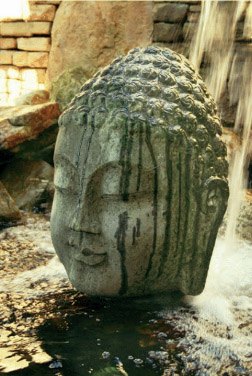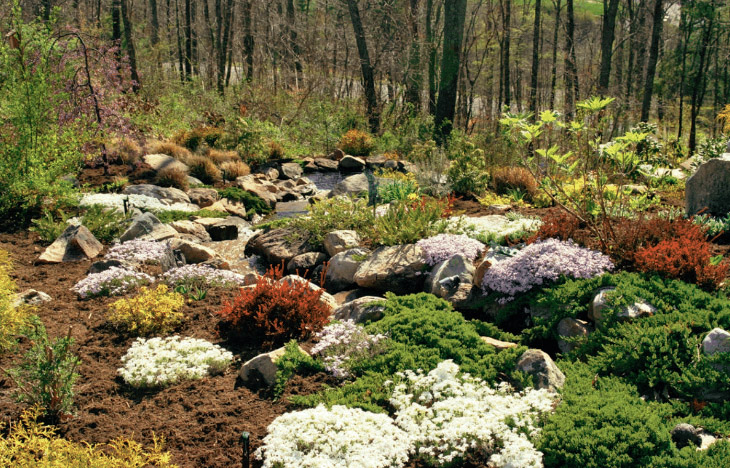
I have been building water features for several years now and have come to realize that no matter how well you describe a water feature, you can only convey the art and feeling with photographs. That is, if you have great photos that are able to capture those feelings with artistry. It was a few years ago, when a local pond builder showed me some pictures that he had taken of his work, that something clicked. One of the pictures he showed me happened to be of a water feature we service yearly and the picture, though nice, did his work no justice at all. It was at that point that I realized that capturing the beauty and optimal photographic potential is a skill.
I began to look at photos of water features and try to determine if the picture was as effective as it could be at representing the feature. Through the years I have seen hundreds and hundreds of waterscapes that could have been represented better if some proper equipment and simple photography skills were utilized. Photography is an art and skill in its own right and can take years of practice to hone, just like building water features. I am by no means an expert in the field of photography, but I hope that some of these basic principles and tips can help capture the photographic potential of your water feature.
Composition
Simple and direct compositions with two or three key picture elements usually create the most powerful and captivating photographs. Composition is the key to successful water feature photography, and if you don’t know where to start, use the “rule of thirds” to get things going.

Break your frame into imaginary thirds on both the horizontal and vertical axes. Place areas of interest at the points at which the lines intersect or along one of the lines. The key is to keep the composition clean and not cluttered with subjects. There should be no question as to what the focal point of the photograph is. To make certain you have accomplished this, it is best to always remember the rule of thirds. This is particularly helpful when composing shots of streams, waterfalls and cascades, as they are often surrounded by a horizon of foreground.
Keep in mind that sometimes this rule can be thrown away. You shouldn’t be afraid to disregard the concepts of composition on occasion. Simplicity is key. Some of the best stream and waterfall shots are made at close range and do not incorporate the whole water feature. You should also be using the rocks, trees, plants and foliage surrounding your water feature; they can add dimension and depth to your photo. When photographing streams and watercourses, look for winding “S” curves and diagonal lines that will carry you through the photo. Whether a moss-covered rock, twisted driftwood or flowering plant is in your photo, make sure a line of water is the focal point.
Beautiful water feature photos are often defined by the quality of the light in which they were taken. As a consequence, I tend to shoot early in the morning or during late afternoon when the sun is lower, or even on an overcast day. For this reason, the hours after dawn and before dusk are known as the “magic hours.” I have taken some of my best shots as the sun was setting and small rays of light penetrated the canopy. Finding the time to get out at dusk or dawn can be a challenge, as can trying to visit two sites in the same day. While you might end up with some unusable photos, you also might create an original and striking masterpiece. Be bold and experiment.

Exposure effects
Water features in motion can be challenging subjects — as they are constantly changing, they can be difficult to photograph. I don’t do a lot of the soft, silky water effects that can be created with Digital Single Lens Reflex cameras (or DSLRs). But if not overdone, this effect can make a waterscape look magical. It creates a certain mood in your photographs, and is created by slowing down the shutter speed. The slow shutter speed will help blur the water and give it that “silky” look that helps show motion in the water. Usually, a shutter speed of a few seconds works well, but ideal speed varies depending on the speed of the water. (Slower water needs a slower shutter.) To help you get a slower shutter speed, try using the lowest ISO setting and a high f-number. Slower-flowing water requires longer exposures to obtain the silky-smooth look, while fast or cascading water can be blurred with relatively “fast” shutter speeds. Pay careful attention to focusing your subjects, specifically the surrounding foliage that might move with even the slightest of breezes. Long exposures require a steady camera, so you’ll need to bring a tripod when you set out to photograph water in motion.
Filters
I shoot a Canon DSLR and carry some filters in my camera bag. There are many uses for filters, but for water feature photography the two key characteristics are their ability to cut out reflections and glare from a scene and increased color intensity. A neutral density (ND) filter cuts down the amount of light entering your lens, allowing for longer exposures. A polarizing filter helps you in two very important ways: it reduces or eliminates the reflections in the water and on the wet rocks, and it helps you get a slower shutter speed (between one and two stops).

morning hours. “We happened to be out mulching and were thankful we had the DLSR in
my truck,” Timmermans said. Canon EOS digital DSLR, F-stop F/8, Exposure 1/200 sec,
ISO-speed 100, Focal length 28 mm.
CAMERA OPTIONS
Point-and-Shoot
Point-and-shoot cameras are so named because the steps to use them are just that: point the camera at something and hit the button to shoot. The camera does all the work for you. The problem is, the camera is rarely as smart as the photographer so the results can be varied. Today’s point-and-shoot (often abbreviated as P&S) cameras are getting more sophisticated with options. While there are still some P&S film cameras, most P&S cameras today are digital.
P&S Features:
- Metering systems, which calculate the amount of light entering the camera
- Variable shutter speed
- Variable aperture
- Zoom lenses
- Automatic focus
Preset controls for various photographic situations, such as:
-
- Landscapes
-
- Nighttime
-
- Close-up or macro
SLR and DSLR Cameras
SLR stands for Single Lens Reflex and DSLR stands for Digital Single Lens Reflex. These terms refer to how the light enters the camera. With bigger bodies than most P&S cameras and change- able lenses, these are the cameras you see many pros and serious amateurs carrying around. They allow for great control over the photography process and allow the photographer to take images that may not be possible with a P&S.
SLR and DSLR Features:
SLRs and DSLRs allow for control over:
- Shutter speed
- Aperture
- Film speed
- Focus point
- Magnification (through the use of various lenses)
- Capability for add-on flashes
- Remote releases
- Filters
Smartphones
Despite the intense engineering focus that goes into a camera’s elements, it’s hard to over-stress the importance of convenience. Smartphones are absolutely the best option for quick uploads to social media and sharing with others. When it comes to producing top-quality photos, however, smartphones are just not there yet.
In a sense, smartphones are just slimmed-down P&S cameras. While many of them boast high megapixel numbers, megapixels alone are no guarantee of good performance. The light sensor, the image processing hardware and the software that ties it all together are what make a good camera. However, sometimes the best camera is the one you have on you.
Smartphone Features:
- Ease of use
- Availability
- Effects
- Ease of sharing
Get the camera that you have at your disposal and start experimenting with some of these simple tips. It’s important to learn to take pictures of other subjects in the landscape, so take pictures of plants and animals as well as water features. The great thing about cameras these days is that most are digital, so wasting film is a thing of the past. I have made it a habit to take a picture every day, no matter what type of camera may be with me, and some of my best photos were taken on days that were not planned as a photo shoot. Once you have caught the photo bug and have honed your photography skills, I recommend looking into investing in some equipment. The investment I have put towards my gear has given me a huge ROI. The other great thing I can say about photography is that it has now become another hobby for me. I find it an adventure trying to get the best shot of each subject, and the ability to do that is truly another form of art.


